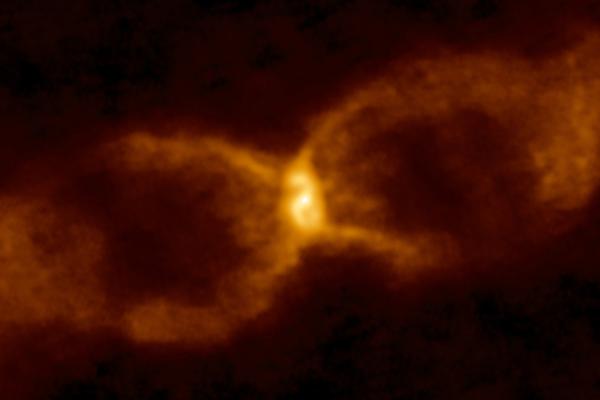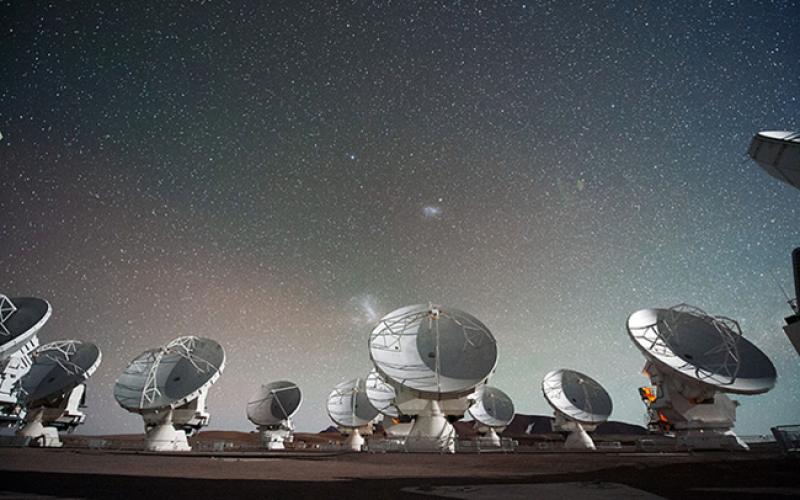Ohio State astronomer helps detect historical stellar merger event

Nearly 350 years ago, a bright speck of light appeared in the night sky just below the constellation Cygnus.
Observers at the time thought what they saw was a nova — an event between two stars in which hydrogen-rich material is transferred from one star to another and results in a brilliant explosion that gradually fades over a period of months.
Recently, however, by using the Atacama Large Millimeter/submillimeter Array (ALMA) in Chile to study the remnants of the stellar event, an international team of astronomers and astrophysicists have deduced that two star-like stellar bodies — a brown dwarf and a white dwarf — collided and merged. It is the first time such an event has ever been definitively identified. A brown dwarf is a failed star that doesn’t have the mass necessary to sustain the nuclear fusion required to turn into a full-fledged star, and a white dwarf is the result of a star that has entered its final stages.
R. Mark Wagner, a research scientist in the Department of Astronomy, was part of the team that studied the collision’s remnants, an hourglass-shaped cloud of material expanding in space and now identified as CK Vulpeculae. Wagner, who is also the science operations manager at the Large Binocular Telescope Observatory in Arizona, has always been interested in stellar merger events.
“I obtained some deep optical imaging data of the field just this past summer using an Ohio State telescope on Kitt Peak [in Arizona],” Wagner said. “We’re still interested in it, and we’ll continue to study it over the years. Perhaps with the data I’ve taken over the last few months, we’ll have even more to say as we move into the future.”
ALMA is a network of 66 radio telescopes situated in northern Chile’s Atacama Desert. The array is capable of highly detailed spatial observations, and researchers were able to investigate CK Vulpeculae and see details not observed before.

The Atacama Large Millimeter/submillimeter Array, a network of 66 radio telescopes in Chile.
The scientists studied light that shined through the cloudy remnants of the collision, and they were able to identify positive signatures of lithium, formaldehyde and formamide, which cannot exist in regular stars. Researchers determined these materials were a byproduct of the collision, and combined with historical documentation recorded in 1670 and other observations, they pieced together what actually happened.
It was concluded that the white dwarf — which was smaller than the brown dwarf but had 10 times the mass — ripped apart the brown dwarf as the two bodies drifted together. The material from the brown dwarf collected around the surface of the white dwarf and was heated, which caused thermonuclear burning that exploded material in opposite directions. The resulting luminescence caught the attention of observers on Earth.
The research and corresponding paper were conducted by a team that included scientists from the University of Central Lancashire, Keele University, the University of Manchester, the University of Minnesota, the University of Warmia and Mazury, Arizona State University and the South African Astronomical Observatory.
“It’s been a privilege to be a part of an international team like this and to help solve a 348-year mystery,” Wagner said. “It’s not the last word. CK Vulpeculae is going to be an interesting and exciting object to study for many years to come.”
.dailypost {background-color:#000; padding:30px;color:#fff;font-family:"capita";font-size: 1.25em;font-weight: 400;} .clicktotweet {float: right; text-align:right;}
An @OSUAstro researcher helped solve a 348-year-old cosmic mystery. #ASCDaily
